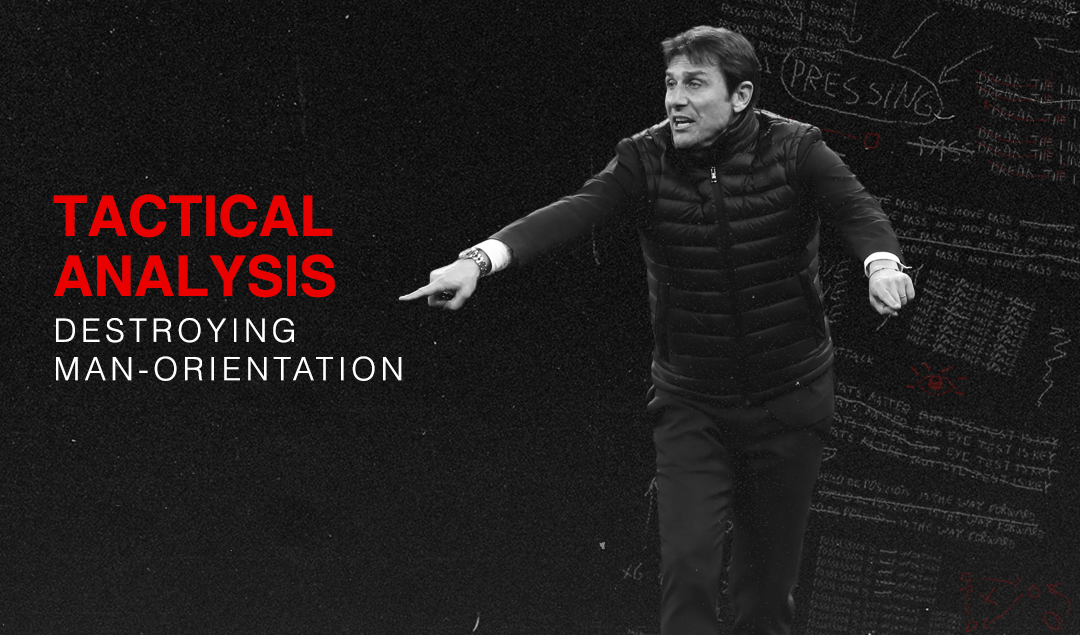Destroying Man-orientation: Antonio Conte Style
The latest and perhaps most important Derby della Madonnina in recent memory showcased an unconditional destruction of Milan, through Inter’s intelligent exploitation of their man-oriented defensive system. This article seeks to systematically analyse how Inter were so effective, attempting to extrapolate more holistic techniques on how to disrupt and destroy man-orientation.
Milan use the ball as a reference point with regards to man-orientation, which means when the ball is central their players in central regions will adopt man-oriented coverage of the opponent, on the right, the players on the right side man orient, and similarly for the left.
This attempts to cause pitch confinement by preventing short central progression through making it difficult for the midfielders to receive while pressuring deep central players, which seeks to drive play down the flanks where the touchline can be used to constrain and achieve effective numerical parity. The weakness present is that coverage of space is dictated by opposition positioning and all defensive actions down the ball-side are reactive giving the opponent the initiative.
Antonio Conte is a manager known for his automatisms, which are most effective when predictable moments can be carved out because they can be enacted more rigidly, without compensating for spontaneous circumstances which might alter what is effective. This explains Inter’s tendency to pass backwards to Samir Handanović as it signals entry to deep consolidated possession where both teams take up predictable stances.
Through automation, Inter seek to increase the speed of thought behind all actions and allow for preparation of subsequent predictable actions allowing them to gain the advantage over the opponent through greater knowledge of anticipated events thus granting control. This is pertinent against man-oriented Milan as by virtue of their defensive system they are always behind and reacting, meaning Inter are in control of the deep possession situation.
Before analysing specific examples, it is important to another structural factor: Milan’s 4-2-3-1 shape has struggled against back threes – the primary reason behind this has been the difficultly in covering for wingbacks as it requires the full-back to push high to press which exposes advanced space which can be exploited by a direct ball which requires zonal covering while the ball is deep in central, but ball sided man-oriented pressure when the ball is played to the wing-back.
This creates an inertia between reaction and reception, meaning the wingback can easily receive possession and has time in on the ball to consider actions before undergoing pressure. This occurs as the wingers are responsible for the opposing centre backs, whereas, against back four structures, the attacking midfielder typically joins the forward line with the wingers orientating position around the opponent’s full-backs.
Moreover, there is a greater necessity to press on the front line against a back three comparatively because the centre backs positioning and greater freedom make them more dangerous actors when progressing, requiring that they be pressured.
Additionally, a more general point about man-orientation is its struggle to adapt against the use of the goalkeeper deep in possession because they are an unaccounted-for actor, meaning they typically have time in possession which allows for the establishment of control, and thus, preparation for automatisms.
The key theme to look out for is the principle of compacting to expand- as Inter exploit their control of Milan’s positioning to increase compactness within certain areas which reduces pitch coverage thus creating a lack of compactness in between the lines for their players with forward momentum to take advantage of.
0 minutes 27 seconds:
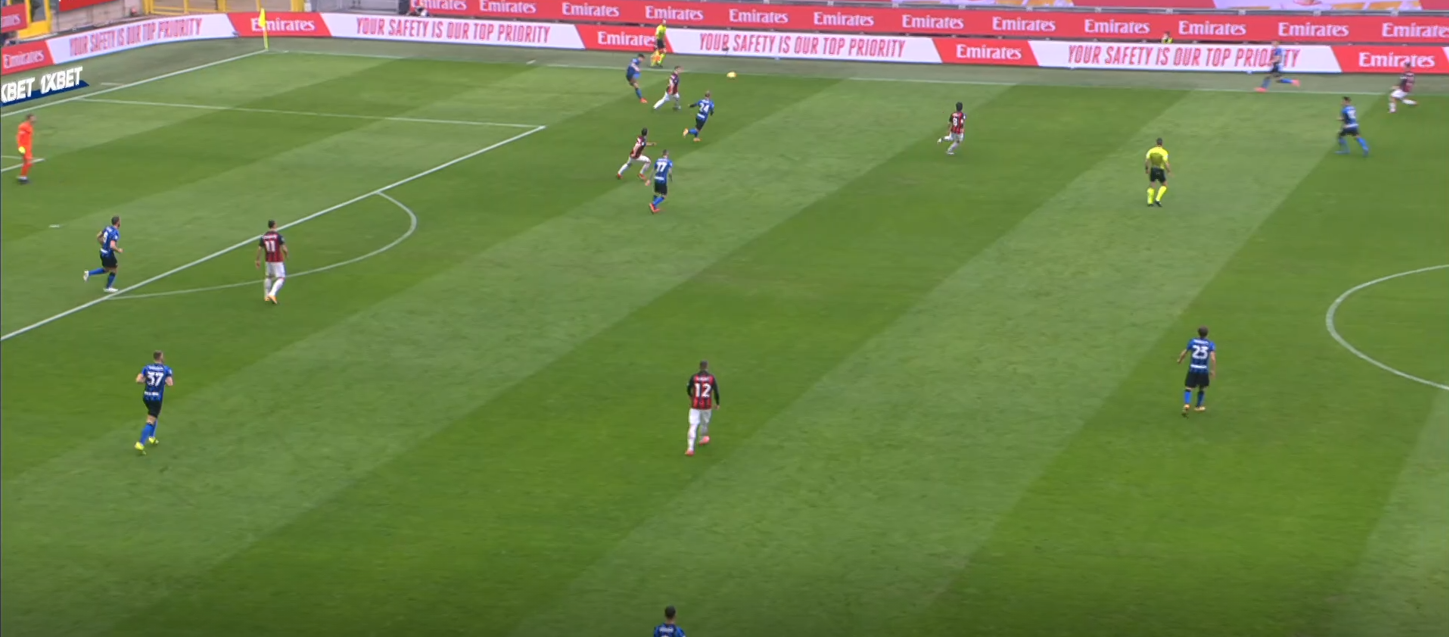
There is a surprising level of nuance to this image. Milan as anticipated adopted ball-side man orientation; however, in response Inter overloaded left flank creating a numerical superiority meaning Sandro Tonali had to drop back to cover Lautaro Martínez.
The small spacing between Christian Eriksen and Alessandro Bastoni seemingly makes this a non-issue as Alexis Saelemaekers can maintain Eriksen in his cover shadow whilst simultaneously pressing Bastoni. However, there is a purpose between the small spacing and Lautaro dropping deep as it acts to reduce the compactness between Tonali and Saelemaekers thus opening space for Nicolò Barella to receive.
The pass was excellently executed by Alessandro Bastoni, one of, if not the most proficient ball-playing centre back in Serie A, demonstrating the performance of these patterns do not exist in the abstract but rather must be tailored to the individual requirements of the respective players on the team, perhaps explaining why Aleksandar Kolarov was acquired last summer as back-up, as he similarly to Bastoni has an exceptional passing range and quality.
It is difficult to capture in an image, as Marcelo Brozović signalling happened quickly, meaning it is better captured on video; but his gesticulating to Eriksen allows for this move to be perceived as automatised, in addition to it happening after two predictable moments, that of goalkeeper possession and kick-off.
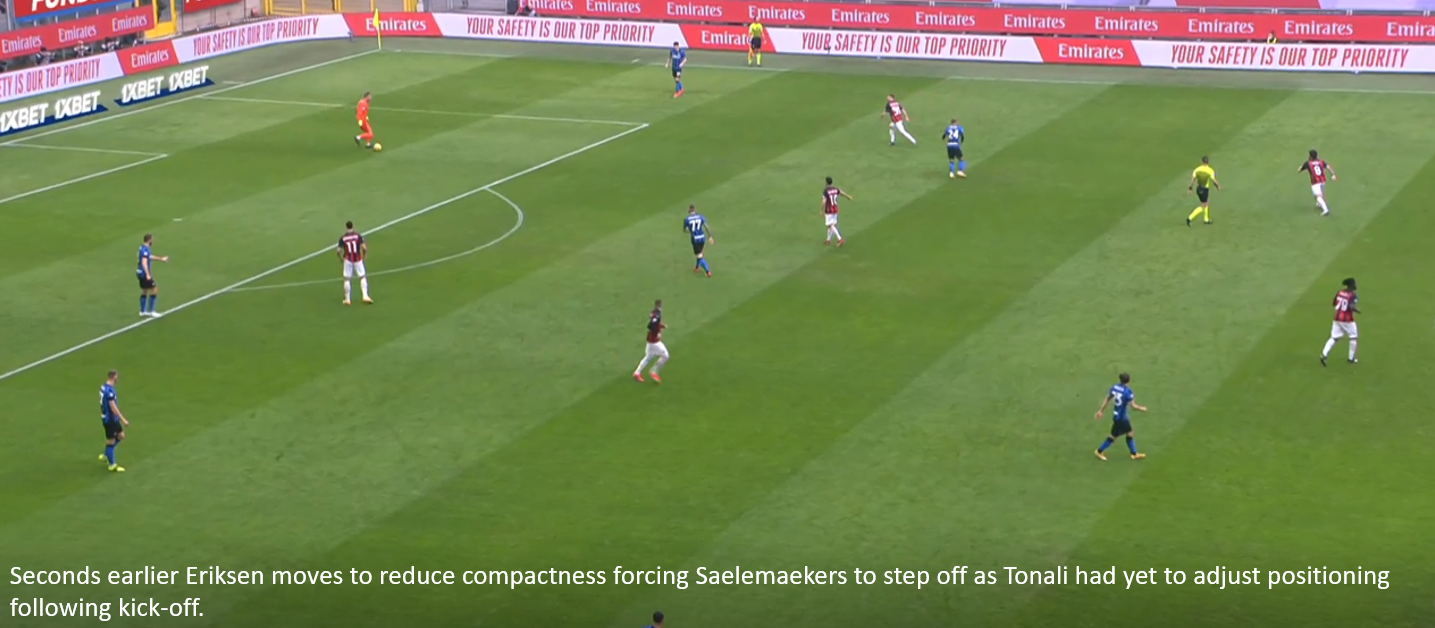
An interesting facet moreover is the antecedent seconds whereby Eriksen moves to increase the distance between him and Bastoni as to make it more difficult for Saelemaekers to have them both covered whilst Tonali adjusts positionally, meaning Bastoni can receive possession as the more advanced player is prioritised.
However, it offered an interesting hypothetical option where the same outcome of a pass to Barella was possible had Saelemaekers more rigidly oriented himself around Bastoni.
4 minutes 15 seconds:
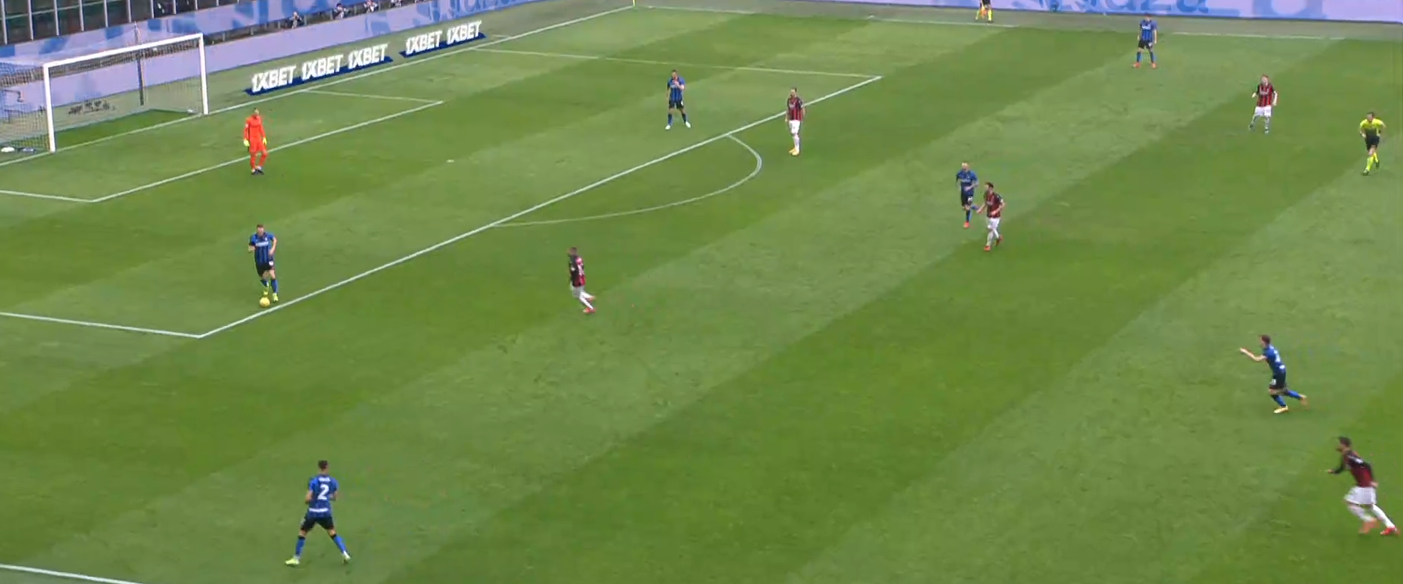
Ball-side man-orientation from Milan on the right flank; however, the problem of the wingback occurs as Achraf Hakimi can receive with time due to the distance Theo Hernandez has to cover. Barella drops deeper, drawing Franck Kessié out of a covering position meaning Alessio Romagnoli is isolated against Romelu Lukaku.
In these types of situations, it is important to remember not all situations of parity are that of equality in the real sense, as Lukaku often has qualitative superiority over defenders when given space to run into.
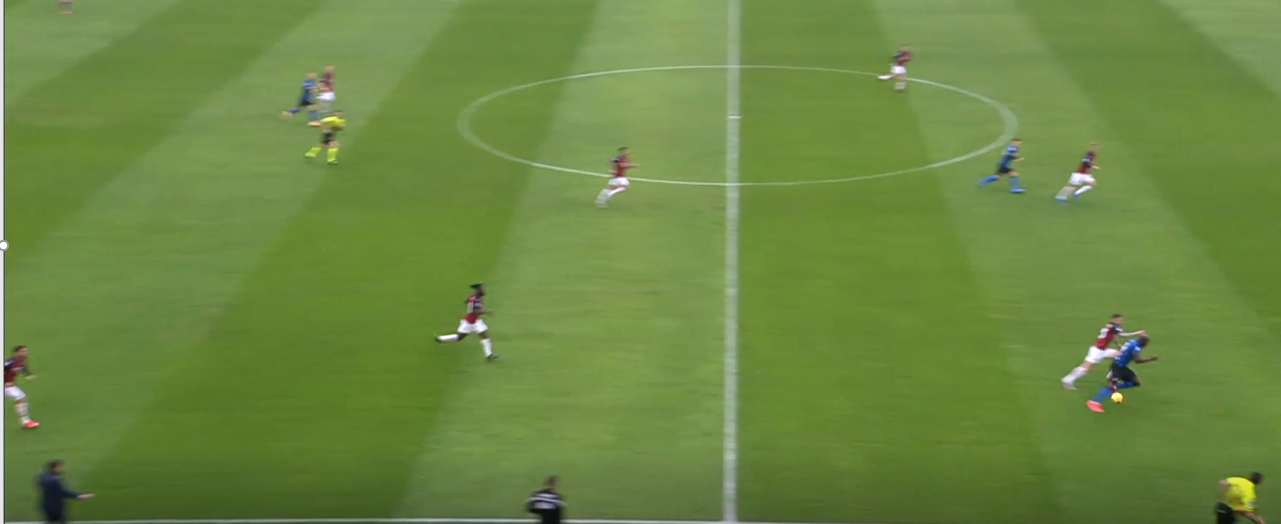
This passage particularly highlights the wingback undermining the foundations of Milan’s pressing scheme as Hakimi can easily play it around Hernandez and down the flank due to the time he has in possession, allowing for a potential goalscoring opportunity situation to be crafted due to lack of spatial coverage and an inability to make ball reception difficult while simultaneously covering for the long ball.
After the initial chance generated, the lack of defensive coverage in response to the introduction to new space via Lukaku’s run was exposed as Barella and Hakimi’s deep positioning influenced that of Kessié and Theo resulting in decreased vertical compactness. In this instance, attempting to limit Inter’s effective space by forcing compactness via backwards orientation failed, exposing Milan’s lack of defensive coverage resulting from the structural ball-side man-orientation.
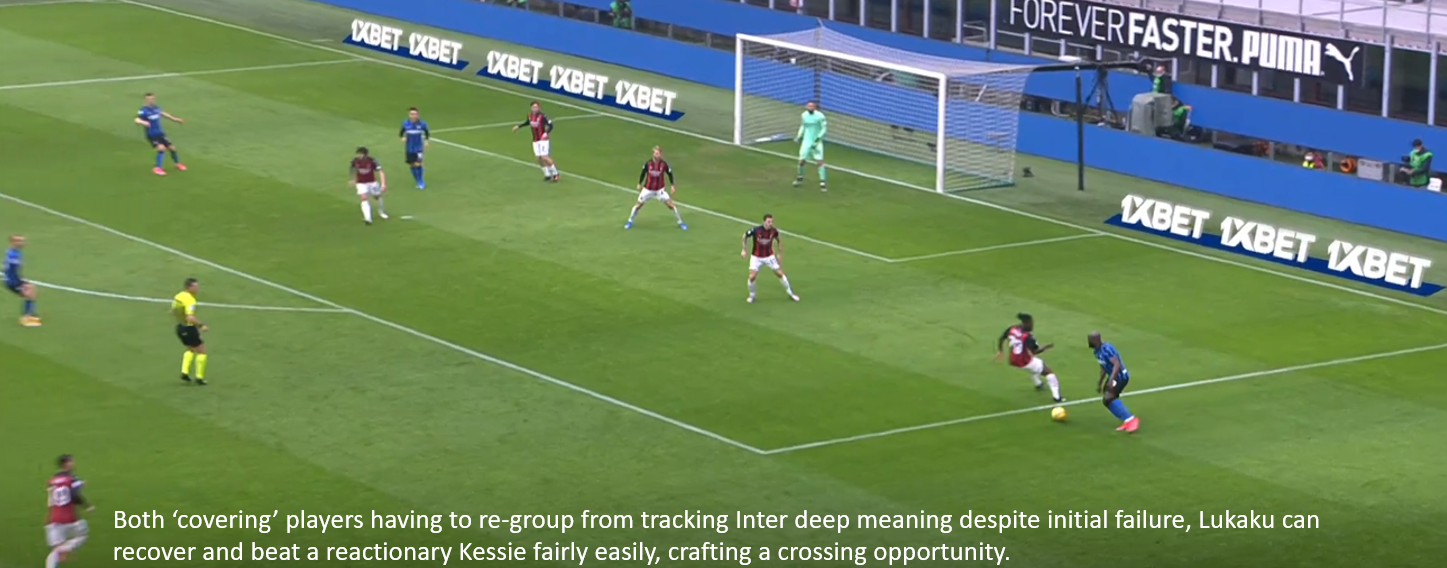
A potential solution posited for Milan in this case while maintaining some of the core elements of their set-up would be outside to in centre back pressing whereby the ball sided winger initially orients himself around the wingback, allowing for centre back reception and then angling his run as to maintain the wingback in his cover shadow. This would allow the centre back more time in possession; but would cover for the wingback to a greater degree whilst not requiring high full back commitment.
The flaw in this strategy for me is the ability for a passing triangle to be created by in this instance, Milan Škriniar, Barella and Hakimi as the passing lane to Barella remains open despite potential tight marking by Kessié as that only prevents progressive actions rather than lateral (as leaving the feet as later trajectory could make it progressive) which still allows Hakimi to be free. The fundamental flaw is with their system as they cannot simultaneously cover the direct pass and the wingback which cannot be reconciled without massive alterations.
7 minutes 7 seconds:

An analogous situation occurs, though, Milan were better able to push Inter out wide which resulted in Hakimi’s attempted pass going just over the touchline. The primary reason behind showing this instance was the good camera angle it generated which demonstrates the space Lukaku has available to receive possession, and the space potential midfield runners can exploit due to man-orientation giving the initiative to the attacking player, increasing the chances of reception due to forward momentum.
Furthermore, Milan’s lack of prioritisation of space generates enough space for contact which isn’t perfect, and perhaps makes said contact desirable because it allows for the continuation of momentum. It, moreover, shows Milan’s orientation well as the far-side full back covers created a back three while Inter’s central and ball-side players face man-orientation.
11 minutes 2 seconds:
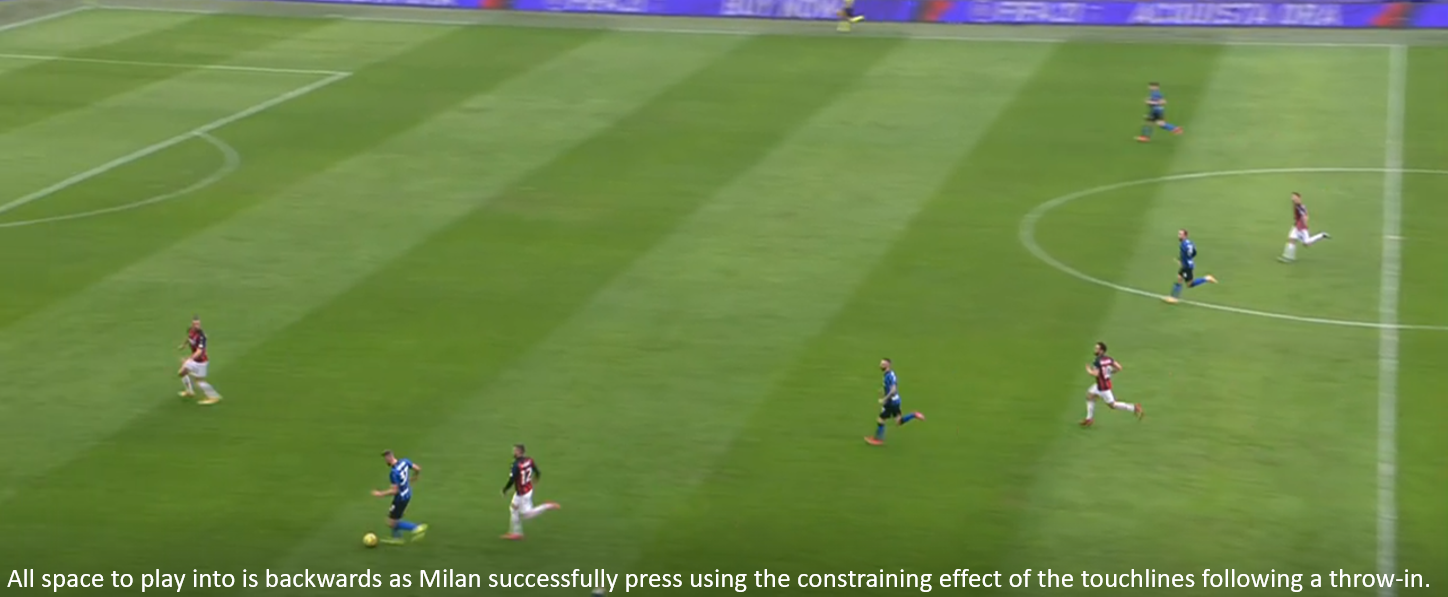
Following a throw-in Inter find themselves constrained so move backwards as to introduce extra depth, using the additional space to move more central eventually finding the goalkeeper allowing them to attain numerical superiority and subsequently establish control, demonstrating that not all backwards passes are negative but rather can be a useful tool in attempting to regain control.
Inter frequently move backwards and centrally after throw-ins to generate time and space rather than attempting to force the issue in a more constrained but more advanced area. Handanović was leisurely in possession as man-oriented marking does not account for the goalkeeper as an actor in possession. This allowed him to pass to a dropping Lautaro, who could receive before Simon Kjær as the defender was reacting to his movement, who subsequently beat Kjær in a 1v1 duel ending in a tactical foul and a booking for the defender.
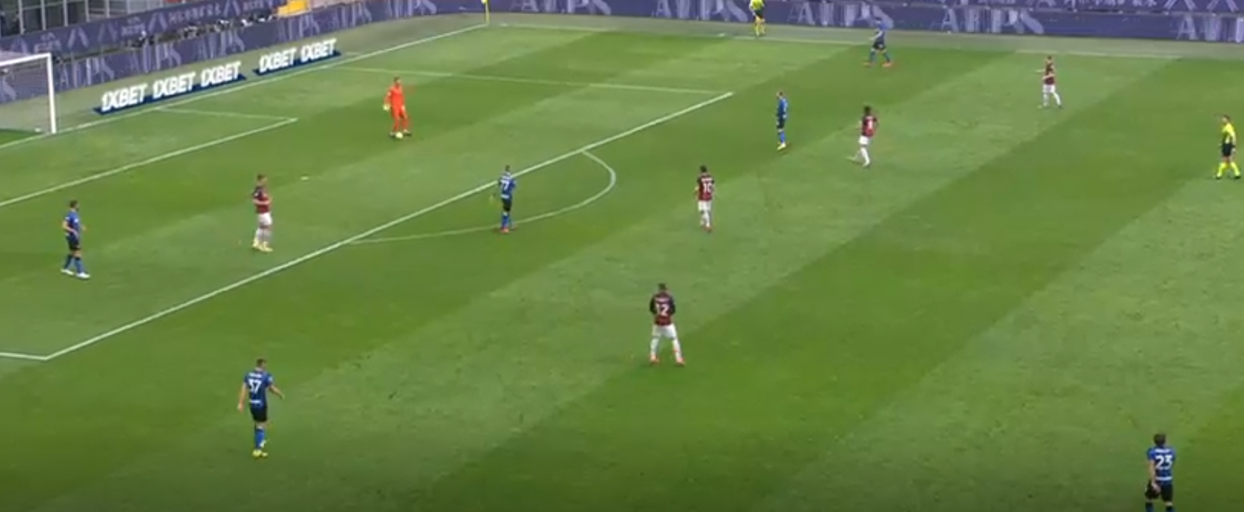
This exemplifies the position manipulation aspect man-oriented sides leaves themselves susceptible to as Inter altered Milan’s spacing in between the lines to increase the emphasis placed on horizontal coverage on the first line which produced a lack of vertical compactness in between the lines. Inter in this instance forged Milan’s static defensive shape through goalkeeper involvement and disproportionate commitment deep to create space in more advanced areas.
13 minutes 3 seconds:
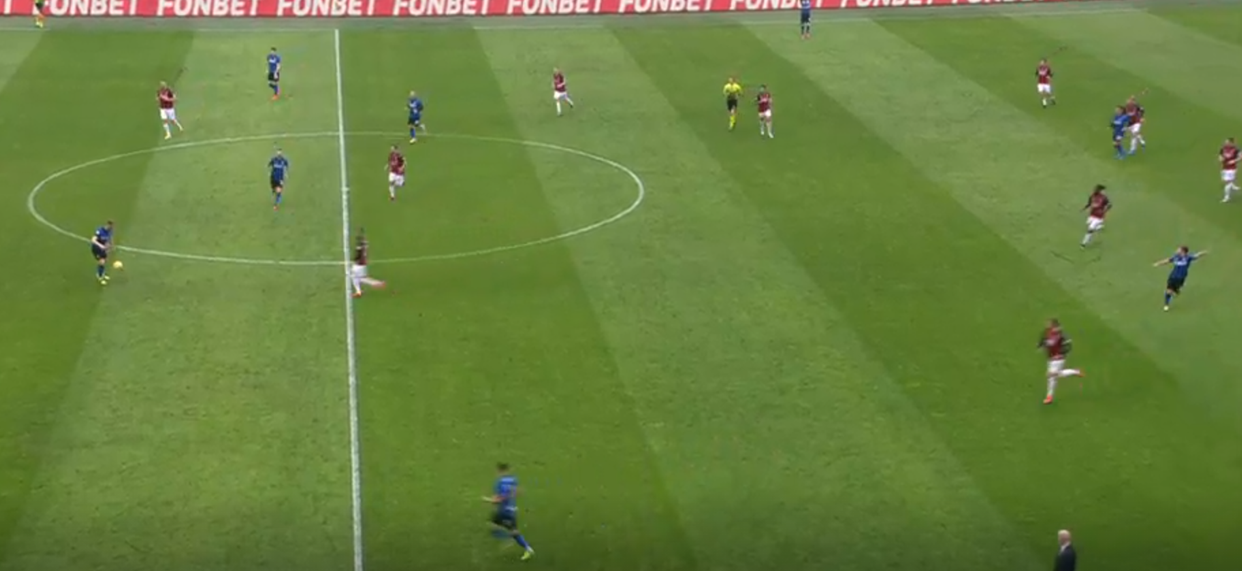
Inter work backwards again from a wide situation, circulating it deep and to the far side as it is the safest route of progression out of Milan’s defensive control. The introduction of new depth forced Milan to cover significant amounts of territory to re-gain their desired defensive structure as the far-side (now near-side players) were previously zonal and deeper as to protect space against more directly penetrative switches. This meant they could not get tight before attempted progression occurred.
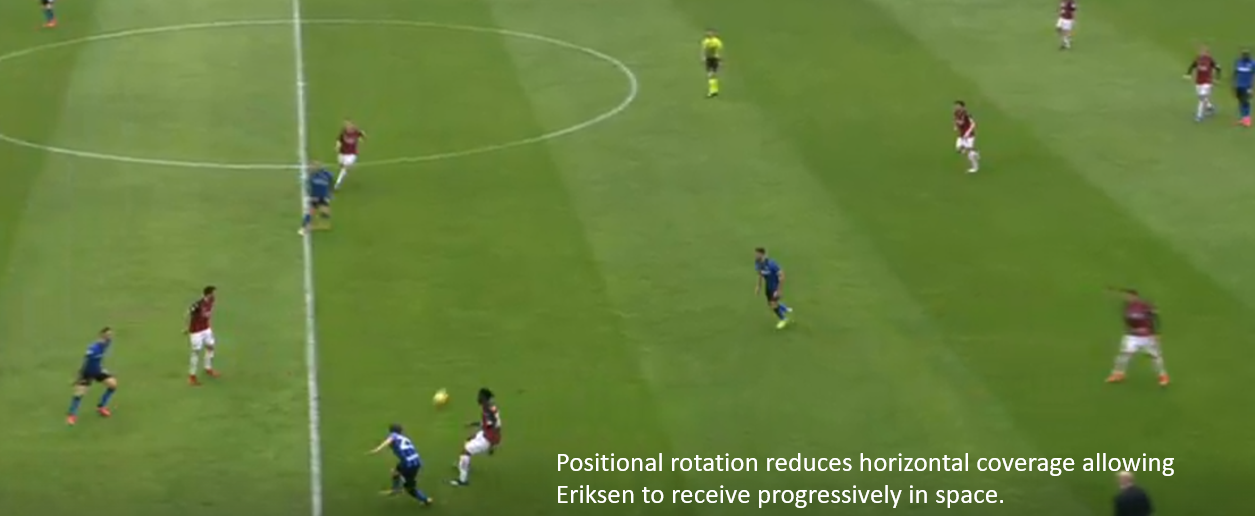
Hakimi then fakes a give and go with Barella forcing Theo deep as he needs to anticipate the more dangerous forward movement creating a whole in Milan’s midfield as Kessié tracked Barella while Theo could not react to the inverted movement of Hakimi to cover. This type of positional manipulation is achieved through straight vertical passing which seeks to make the opposition markers positions overlap vertically reducing horizontal coverage.
20 minutes 23 seconds:
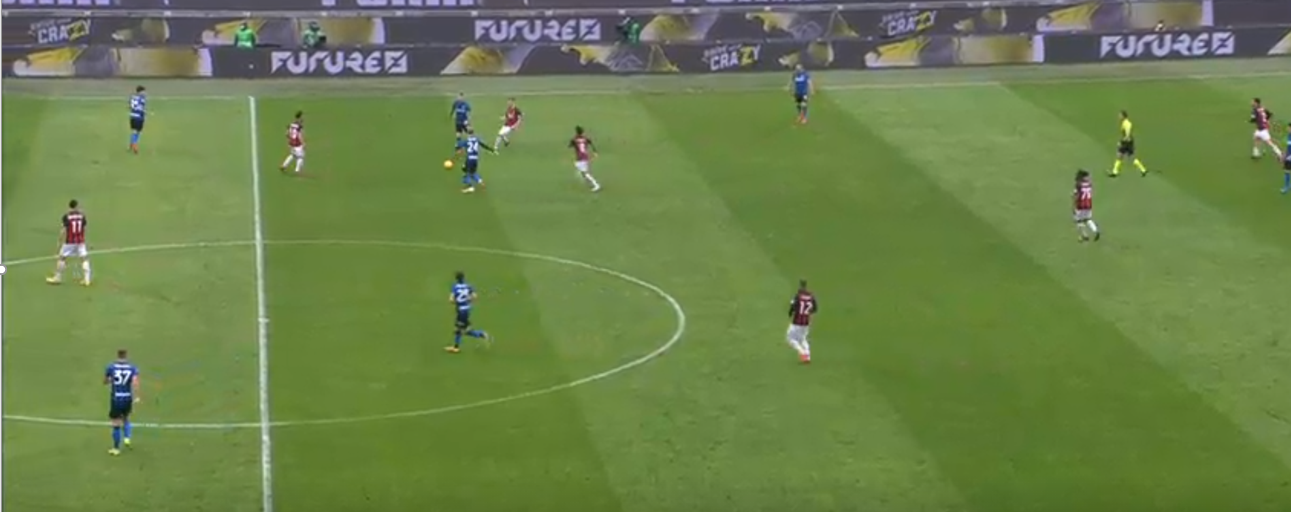
This is a slightly different occurrence as it arose directly from a turnover in possession meaning Milan’s defensive structure was not fully in place and thus responsibilities were allocated slightly differently (Saelemaekers on Brozović and Hakan Çalhanoğlu on Bastoni). Nonetheless, it demonstrates the element of lack of coverage in between and inability to solve the wing back problem.
Davide Calabria is not tight on Ivan Perišić as Lautaro is drifting in wide regions meaning moving tight too quickly could open up space to easily for the direct ball down the channel, in addition to the post turnover situation resulting in Theo temporarily occupying the right flank meaning an instant pass was unlikely hence a reticence to go unnecessarily tight.
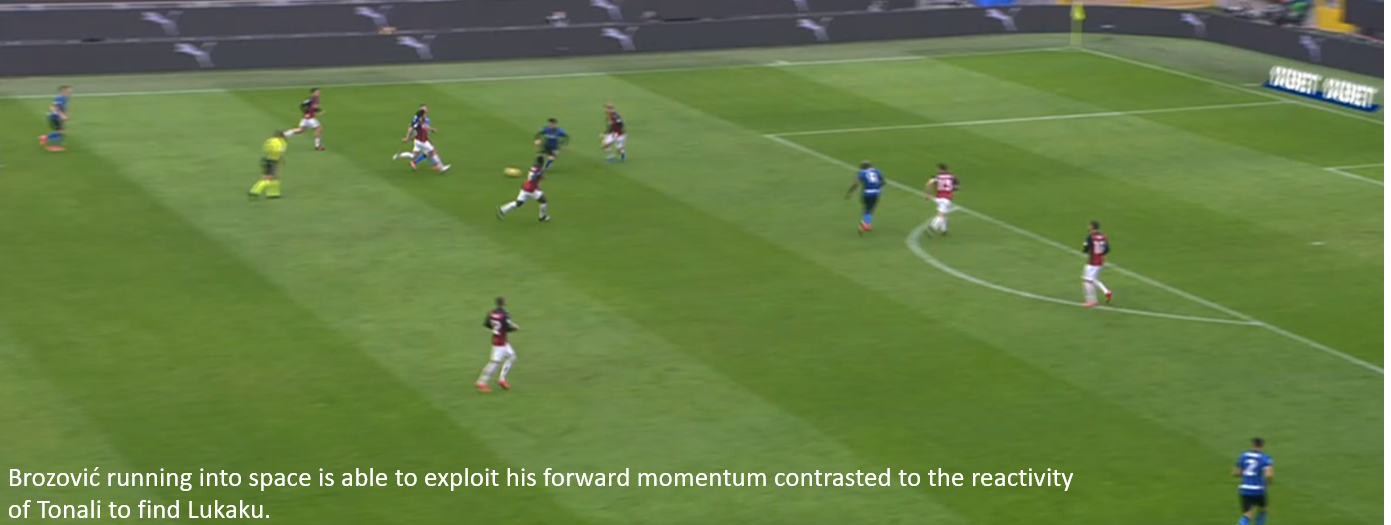
As a consequence, Inter were able to achieve numerical superiority through having a compact triangle with the free man of Perišić who could be found after circulation. The compactness of the triangle created more space in between the lines for reception and potential runs, which elucidates the ongoing theme of Inter compacting to vertically stretch then exploiting the space created through runs which the player to receive running forward onto Milan’s goal.
23 minutes 56 seconds:
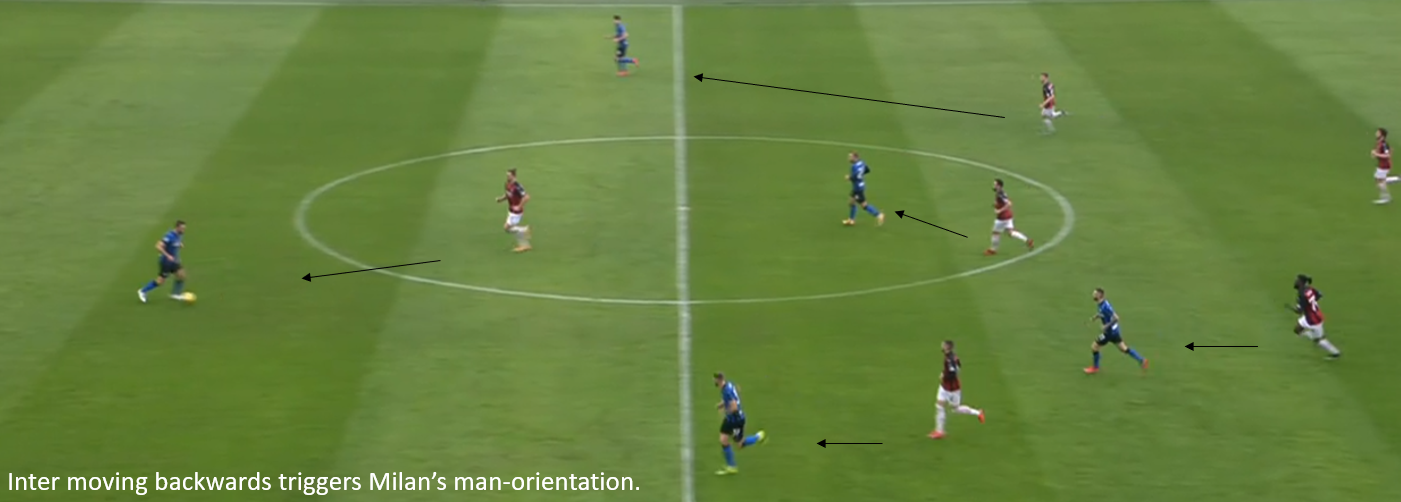
Inter move the ball backwards from a wide area, this serves the purpose to invite Milan’s press forward while allowing possession to consolidate centrally. This is a common defensive strategy even for teams which do not typically adopt man-oriented stances from static possession as moving backwards can create a vicious cycle for the team in possession.
In doing so, it allows the opponent to continually force possession back through forcing the player in possession to receive with a backwards body orientation as they are facing their own goal in an attempt to support the player in possession potentially isolated deep resulting in their passing angles being lateral or backwards thus allowing for consistent pushing backwards as each player is limited to backwards options.
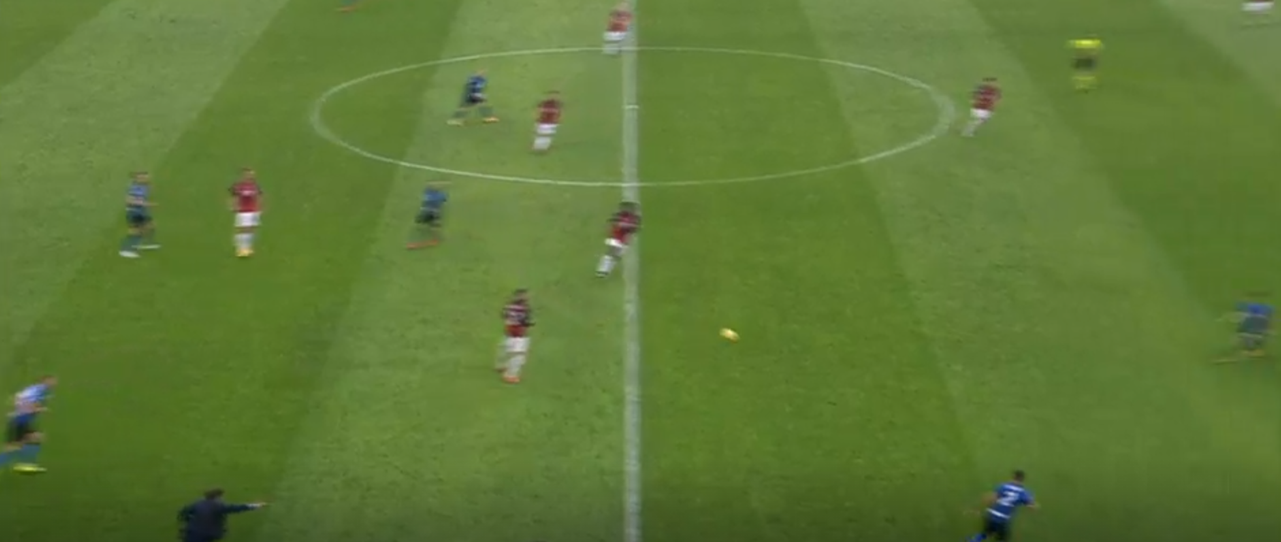
However, Kessié advancing alongside Brozović left Milan Barella free in midfield to receive in between the lines as Inter successfully reduces their vertical compactness, while Škriniar’s intelligent movement to the deep full back position created an alternative for Stefan de Vrij while serving to reduce the horizontal compactness between him and Kessié opening the passing lane to Barella.
The issue in this instance was the lack of responsiveness between the defensive line and man oriented pressing players as the defensive line did not push up in conjunction creating a massive gap in between the lines, demonstrating the utility of changing depths for Inter as it disrupted defensive organisation.
The opportunity does not result in anything significant because of a poor touch from Barella; however, it created a potential transitional moment insofar as should Barella have controlled the ball in a fashion more typical for a player of his quality, Inter would have been in a 3v2 situation down the right flank running at the last line of Milan’s defence.
24 minutes 33 seconds:

Afterwards Inter moved backwards again and created a transition through playing through Milan’s press, in this instance, they moreover capitalised upon the disorganisation of Milan through compacting to expand – switching from side to side, forcing Alexis Saelemaekers in particular to cover a lot of ground to aid in achieving ball side man-to-man tight marking to compensate for Zlatan Ibrahimović’s lack of intensity.
This meant the Milan players were not marking their common men upsetting shape when the pressing state changed, which Inter provoked through their switches. Zlatan, left responsible for Eriksen dropped his responsibility as Inter progressed, giving Eriksen space to move forward as a tired Saelemaekers following intense side-to-side pressing was not instantly aware, allowing Eriksen to receive with time and space, which are the fundamental elements in exposing an opponent’s lack of defensive coverage helping him to find Barella in space.
27 minutes 8 seconds:
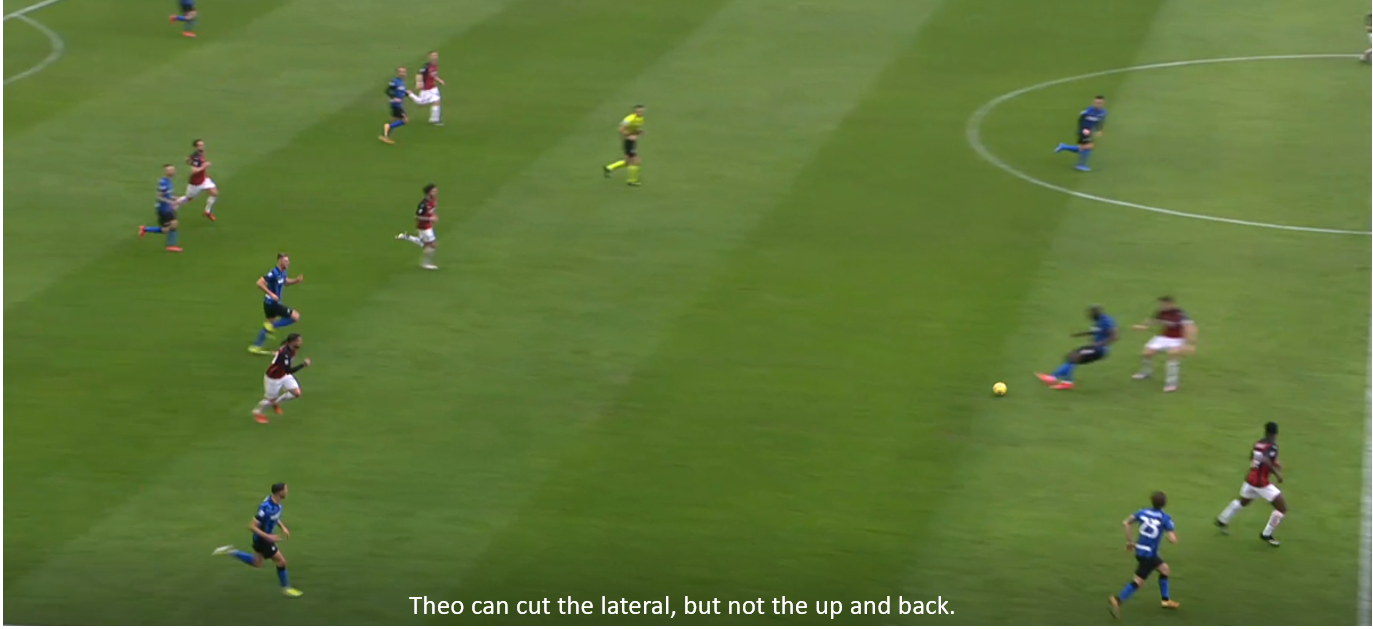
Handanović in deep possession forces pressure from Çalhanoğlu, the ball cycles out to Škriniar adopting a deep full back position as Inter seek maximal pitch coverage vertically and horizontally as to stretch Milan who follow their movement. Ante Rebić presses with intensity but from distance, allowing Škriniar to beat him in a duel fairly easily as he cannot easily alter his body orientation.
This introduces another element of man-orientation which is the necessity to compensate for a lost duel which Theo does; however, covering is often insufficient when the ball continues on the ball side and the player who lost the duel is unable to recover as in this example Theo is presented with the impossible task of pressing Škriniar whilst maintaining Hakimi in his cover shadow and ultimately fails at both as a pass from a relatively unperturbed Škriniar to Lukaku opens the passing lane to Hakimi, who can find Barella to exploit the lack of compactness in between the lines.
35 minutes 39 seconds:
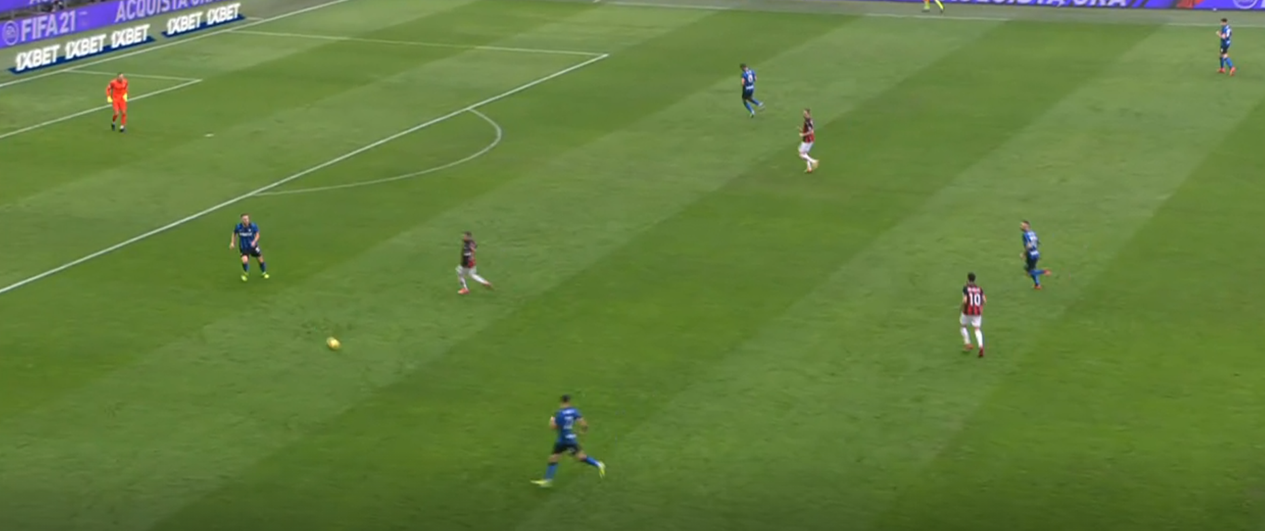
A turnover occurred following a Milan direct ball, Inter move backwards to consolidate and establish a 4 vs 3 superiority. Çalhanoğlu tracks Brozović despite him being covered by Rebić’s shadow rather than moving to Hakimi. This is understandable as Brozović is his ‘man’.
Hence illustrating the issue as Milan were not prepared for man-orientation following the turnover yet attempted it despite lacking the critical element of parity within effective space. Çalhanoğlu was presented with a conundrum: contextually adapt or follow the system; he chose the latter, justifiably as to deviate from a rigid plan could potentially undermine his teammates efforts inadvertently as he could not act under the same pretence as somebody watching with a better angle with regards to perceiving structure.
This gave Hakimi time and space to generate momentum for a give and go with Barella while also allowing Lukaku to receive with space behind him as Kessié had to cover in wide areas allowing for a switch to Perišić to occur resulting in a dangerous shot and ricochet. The issue here was the system which forced Çalhanoğlu’s choice rather than Çalhanoğlu’s decision as an individual.
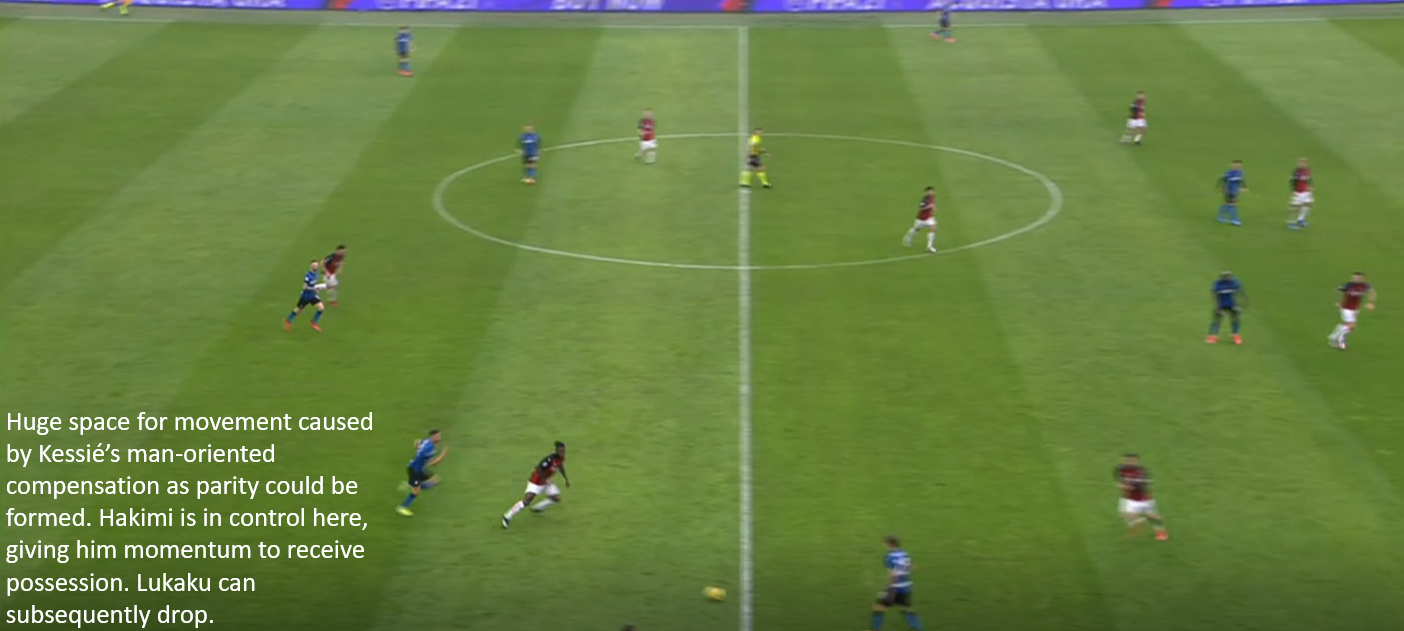
Moreover, losing out in these situations is common regardless of system; however, the ramifications for losing were particularly bad due to poor spatial coverage following deep possession and the continued insistence on getting tight seen with Kessié on Hakimi as parity could be achieved should considerable distance be covered – thus demonstrating the issue of wingback time and space before proper coverage
Consequent from covering this distance, space is generated in between the lines due to reduced vertical compactness allowing Lukaku to drop off and Hakimi to run into. Juxtaposing momentums give Hakimi the advantage as he is moving into the space progressively whereas Kessié must react to Hakimi’s closing of the space, pivoting, slowing himself down as he follows the movement of the Morocco international.
50 minutes 4 seconds:
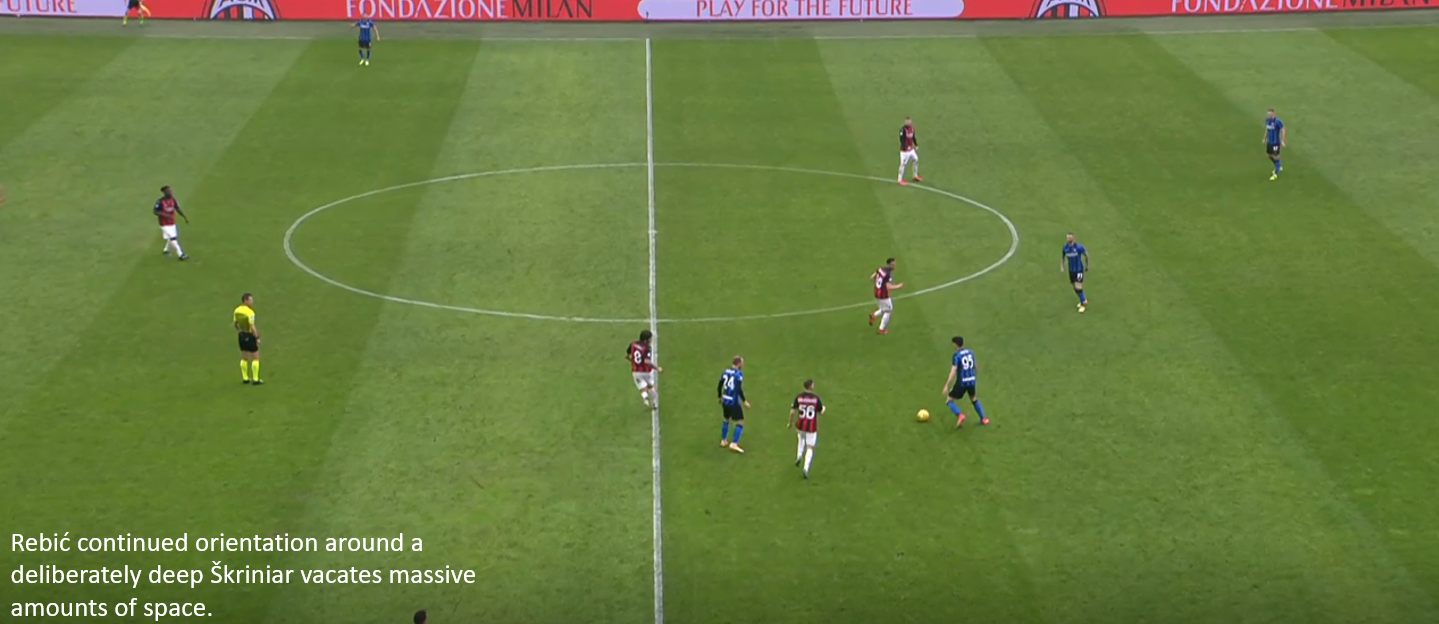
The frequent Inter moving backwards from a wide area occurred engaging Milan’s man-oriented press – as typically they had to cover significant distance resulting in Bastoni initially being under no pressure. This allowed him to progress inwards to open more passing options.
Eriksen compacted his positioning while Brozović moved deeper dragging Çalhanoğlu having the effect of pushing Milan’s pressing line forward while not reducing the space in between the 2nd and 3rd lines allowing for Bastoni’s pass to be executed successfully in between Çalhanoğlu and Tonali. What I find remarkable here is the rigidity despite clear positional manipulation. Inter vertically stretch Milan through the backwards movement, perhaps most clearly demonstrated by Škriniar dragging Rebić deeper which allows the pass to travel through a ghost town to Hakimi.
Varying depths disrupts opposition positioning, particularly concepts of correct distancing in between the lines in relation to pressing, as pushing up too quickly could leave them exposed to a pass in behind from the deep player with time in possession to expose the space whilst failure to proportionally push up creates huge spaces in between the lines elucidated by this example. Inter continually manipulated the deeper pass as a trigger to Milan’s man-oriented pressure to reduce vertical compactness allowing often the far-side midfielder or wing back to receives completely unperturbed.
56 minutes 7 seconds:
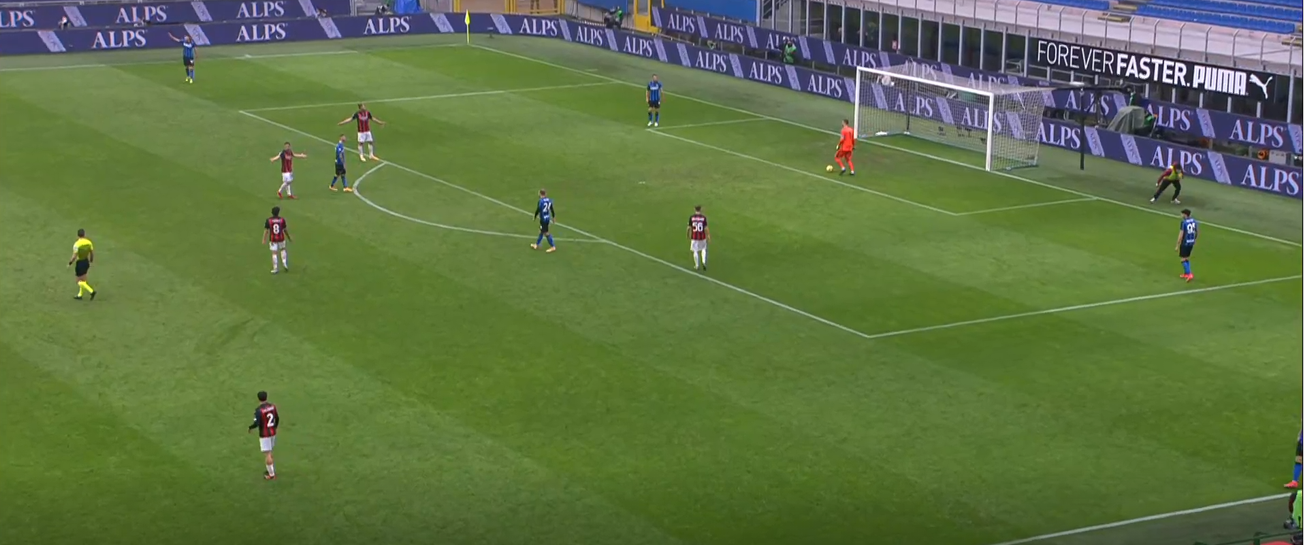
Inter adopt their flat back four goal kick set-up for maximum vertical and horizontal stretching, Milan man-orient centrally in accordance with their scheme generally meaning they are stretched horizontally. As play progresses, as occurs with man-orientation they commit themselves to the ball-side in accordance with Inter, and subsequently increase commitment upon lost duels as to ensure numerical parity/that all possible ball recipients are marked. The more men committed to the ball-side; the less other areas are covered.
Barella starts higher than Eriksen in this example as to allow himself more time in possession when he ultimately receives as by dropping from deep, as Kessie needs to worry somewhat about covering the direct option before getting tight, he engages in that aspect when Barella can directly receive possession, thus granting him more space to collect as Milan’s forward pressing line is pushed high.
Having the initiative over his man-oriented marker in Kessié aids here as in previous instances – he knows when he will become an actor for direct possession due to the automatisation allowing him to better anticipate antecedent actions. Here more than previous examples, the qualitative advantage of Lukaku is displayed as he can reliably hold himself up against man-oriented markers allowing for runners to support and exploit the space generated through breaking the lines initially to find Lukaku.
Seeing Tonali covering, Theo attempts to compress with Romagnoli onto Lukaku; however, Hakimi with forward momentum can receive in the limited space as Lukaku is able to release the ball. Tonali being required to cover eliminates Milan’s zonal coverage in the centre as that is the element sacrificed when a duel is lost as a contingency.
Likewise, the ball-side commitment results in an underloaded far-side easily accessible through the vacant centre. Thus, Lukaku’s presence and ability to hold-up possession drew Milan’s zonal cover out of position allowing Inter’s runners to exploit the space left unprotected. Eriksen then has uncontested possession in a dangerous area, finding Perišić in space who exploits the defensive state of retreat through a cut-back resulting in Inter’s second.
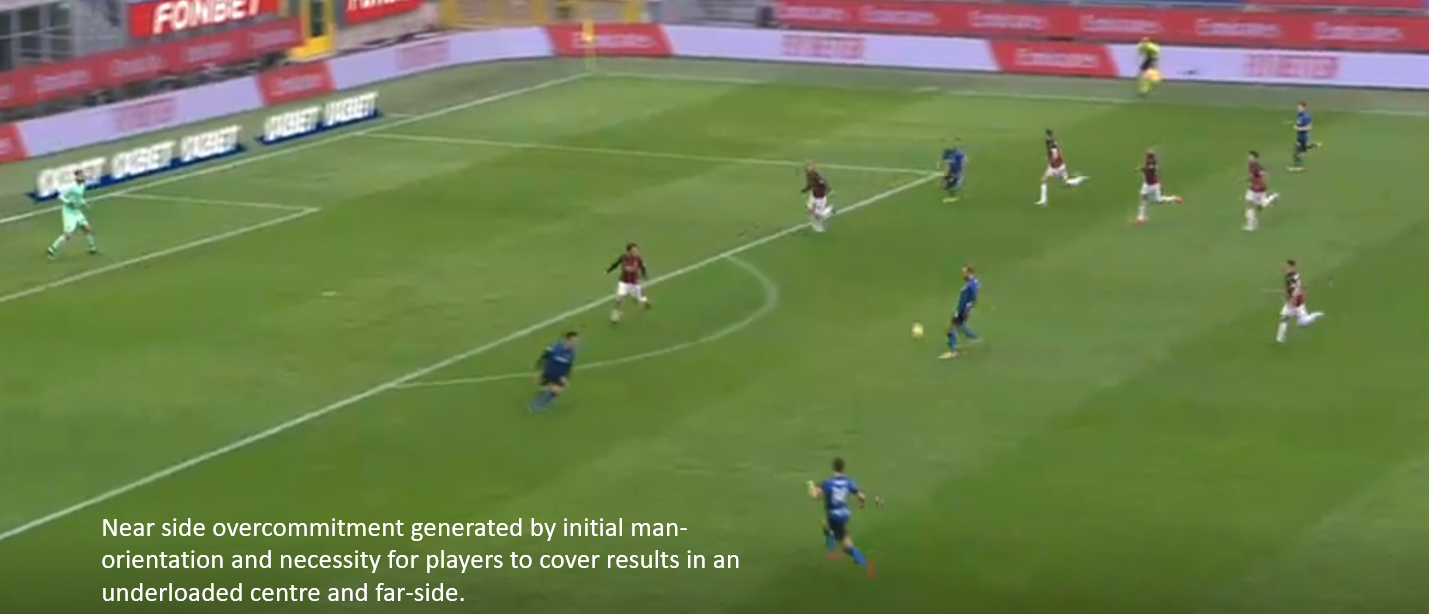
The primary aspect highlight in this example is Lukaku’s capacity to hold-up possession and draw opponents to the near-side where the overload provided by Hakimi/Barella provides sufficient dangerous options to either generate a dangerous pass directly or to free up space for a switch himself to the underloaded far-side facilitating territorial gain or an advantageous 1v1 dribbling opportunity for Perišić.
Ultimately, when the attempt to constrain and limit options fail through attempting to mark all options and make ball reception difficult and oriented around the constraining element (by-line and/or touchline) the lack of zonal coverage is exposed.
Milan did not execute their plan particularly poorly here – they were just limited by the fact that not all situations of parity are that of equality – getting tight 1v1 vs Lukaku quite often is not enough, and benefits his playstyle, which undermined their defensive system. Kessié getting tight to Barella earlier would have likely just accelerated the process by which Lukaku received possession through a direct ball rather than alter the outcome greatly when looking macrocosmic.
This situation would have manifested differently as it is a unique manifestation of the circumstances, but larger picture without the benefit of hindsight, Lukaku wins the duel most occasions, and can lay off for the up-back and through with Hakimi, which is often what happens when Barella is marked tightly deep. Hakimi can often invert into the vacated space when dribbling additionally. In essence, the ability of Lukaku provides Inter with a multiplicity of great attacking options when the opponent man-orients in midfield.
64 minutes 53 seconds:
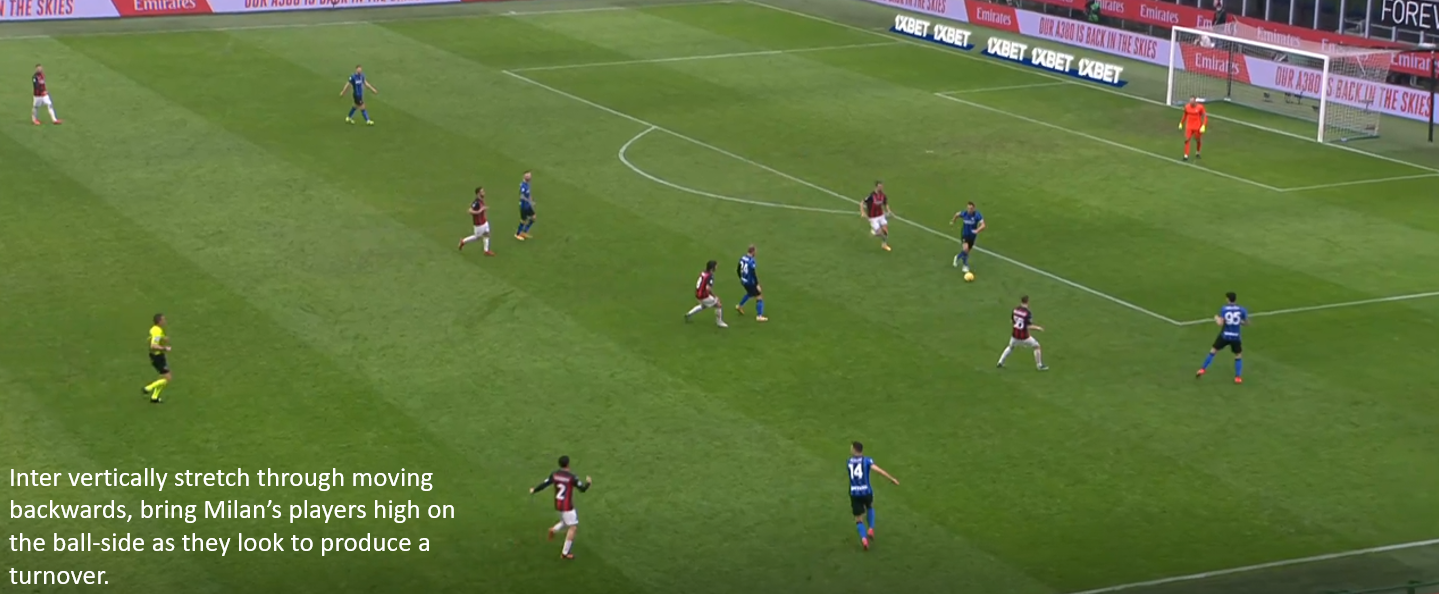
Fairly standard scene by this point; however, interestingly, out of picture Lautaro drops deeper with no intention of receiving possession to draw Kjær out of position. This detaches the left flank from right which is fully committed deep knowing Milan will follow accordingly to the advanced right of Lukaku, Barella and Hakimi allowing Perišić to hit a seemingly hopeful ball into space as he is aware of the automatised aspect of the overload to isolate.
Here, the defensive line is limited in their capacity due to Inter playing so deep eliminating the ability for them to push up to reduce effective space as they are robbed of the tool of offside, generating a huge space in between the lines, which have essentially become two lines rather than three in accordance with Inter’s detachment in possession.
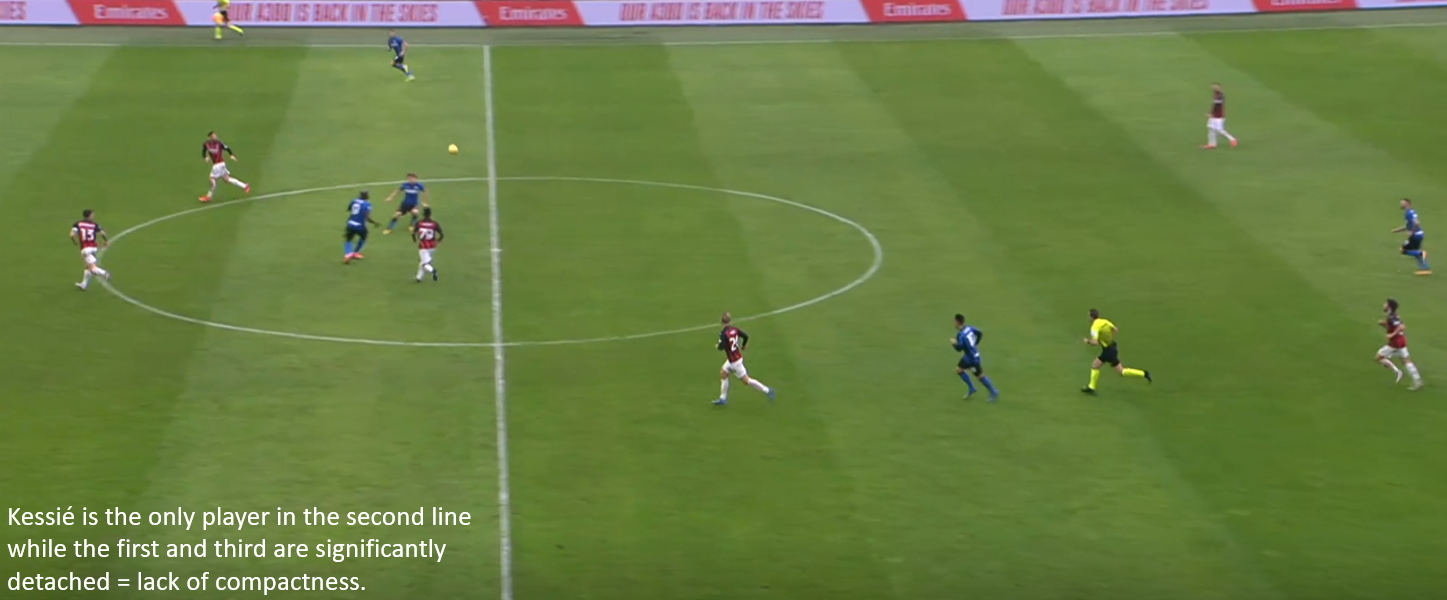
This illustrates the ability of playing out of defence to create transitional moments which are when the opponents defence is not consolidated, and are often reacting to the actions of the attackers constantly introducing new space due to previously exposed compactness.
These moments happen less frequently against low blocks because they refuse to allow space in between the lines and do not risk for the potential gains of a high turnover (the issue here is often more with sustained pressure, although transitional moments can occur in the final 3rd, just less frequently because of how compact and deep the opponent – different issue for a different article).
These occur because the opponent is allowed too much space, and/or have too many options in possession meaning extreme coverage and compactness (for Milan here, as they compacted according to Inter’s desire) in defence often provoke these situations. Milan had to vertically cover deep areas due to the depth of Inter’s build-up while their defence scheme forced partial extreme compactness creating space in between the lines.
The option for Romagnoli subsequently was either engage with Lukaku early and risk losing the duel early and hence expose even more space in behind where Lukaku can advance without pressure or drop off granting territory while attempting to guide him to less dangerous areas in wait for defence support. Romagnoli dropped, and pushed Lukaku wider; however, he had advanced far enough to get in a dangerous shooting position, eventually scoring.
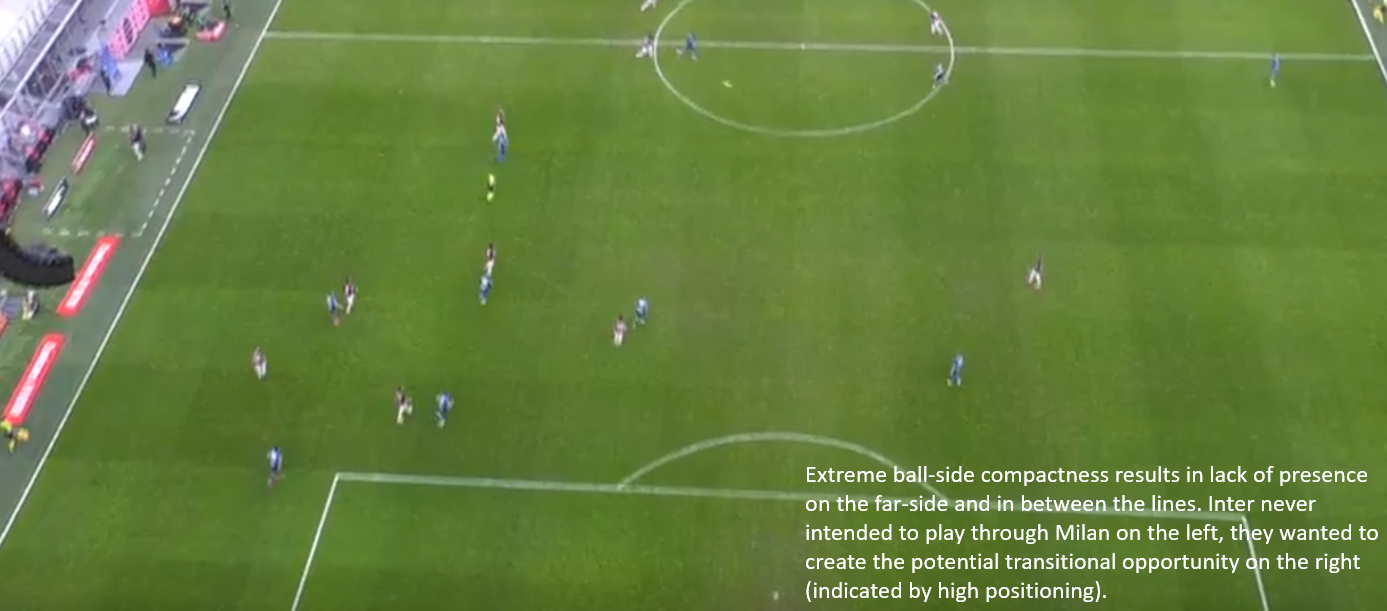
In summation, the purpose of this article is to demonstrate the consistency with which a well drilled and technically proficient side can manipulate a man-oriented pressing scheme through creating space in between the lines by vertically stretching through deep possession, allowing the forward players and subsequent runners to receive in space. In essence to show the effect of ceding control of positioning to an opponent when that opponent is incredibly good in possession and have players resistant to tight man marking such as Lukaku.
By: @mezzala8
Featured Image: @GabFoligno / Jonathan Moscrop / Getty Images
